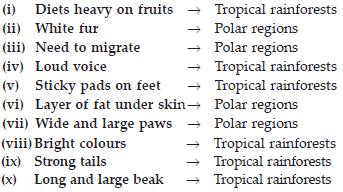Weather Climate and Adaptations (Biology) Class 7 - NCERT Questions
Name the elements that determine the weather of a place.
SOLUTION:The elements which determine the weather of a place are: temperature, humidity, rainfall, wind speed etc.
Q 2.When are the maximum and minimum temperatures likely to occur during the day?
SOLUTION:The maximum temperature of the day occurs generally in the afternoon while the minimum temperature occurs in the early morning.
Q 3.Fill in the blanks:
(i) The average weather taken over a long time is called .................... .
(ii) A place receives very little rainfall and the temperature is high throughout the year, the climate of that place will be .............. and ............... .
(iii) The two regions of the earth with extreme climatic conditions are ...................... and ....................... .
(i) climate (ii) hot, dry (iii) desert region, polar region
Q 4.Indicate the type of climate of the following areas:
(A) Jammu and Kashmir ........................
(B) Kerala ........................
(C) Rajasthan ........................
(D) North-east India ........................
(A) Moderately hot and wet
(B) Hot and wet
(C) Hot and dry
(D) Wet
Which of the two changes frequently, weather or climate?
SOLUTION:The weather at a place changes frequently, as it is based on day to day conditions of the atmosphere at a place, with respect to the temperature, humidity, rainfall, wind speed etc. Any of these elements can vary over very short periods of time. Climate of a place is defined as the average weather conditions at a particular place over a long period of time, say 25-30 years or more. Climate of a particular place does not change frequently, rather it remains more or less constant.
Q 6.Following are some of the characteristics of animals:
 For each characteristic indicate whether it is adaptation for tropical rainforests or polar regions. Do you think that some of these characteristics can be adapted for both regions?
For each characteristic indicate whether it is adaptation for tropical rainforests or polar regions. Do you think that some of these characteristics can be adapted for both regions?

The tropical rainforest has a large population of animals. Explain why it is so.
SOLUTION:The tropical rainforests have large population of animals because these regions experience continuous warmth and rain throughout the year. Such climatic conditions in rainforests are highly suitable for supporting an enormous number and a large variety of plants and animals.
Q 8.Explain, with examples, why we find animals of certain kind living in particular climatic conditions.
SOLUTION:We find animals of certain kind living in particular climatic conditions because animals are adapted to survive in the conditions in which they live. Animals living in very cold and hot climate possess special features to protect themselves against the extreme cold or heat. For example, animals in the polar region like polar bears are adapted to the extremely cold climate by having some special characteristics such as white fur, strong sense of smell, a layer of fat under the skin, wide and large paws for swimming and walking etc. Similarly, many animals living in tropical rainforests have sensitive hearing, sharp eyesight, thick skin and a skin colour which helps them to camouflage by blending with the surroundings, e.g., lions and tigers.
Q 9.How does an elephant living in the tropical rainforest adapt itself?
SOLUTION:An elephant living in the tropical rainforest has adapted to the conditions of rainforests in various ways :
1. It has large ears with a keen sense of hearing. The large ears also help to lose heat from the body and keep it cool.
2. The nose is modified in the form of trunk due to which it has a stong sense of smell.
3. It also uses its trunk to pull down fruits and leaves from the trees to eat.
4. It has a unique foot structure, which helps it to walk over uneven surfaces and swampy ground.
5. Adult elephants develop tusks and use them to tear the bark of the trees, which the elephants eat.
Choose the correct option which answers the following question:
A carnivore with stripes on its body moves very fast while catching its prey. It is likely to be found in
(i) polar regions (ii) deserts (iii) oceans (iv) tropical rainforests

Choose the correct option which answers the following question:
Which features adapt polar bears to live in extremely cold climate?
(i) A white fur, fat below skin, keen sense of smell.
(ii) Thin skin, large eyes, a white fur.
(iii) A long tail, strong claws, white large paws.
(iv) White body, paws for swimming, gills for respiration.

Choose the correct option which answers the following question:
Which option best describes a tropical region?
(i) hot and humid
(ii) moderate temperature, heavy rainfall
(iii) cold and humid
(iv) hot and dry
